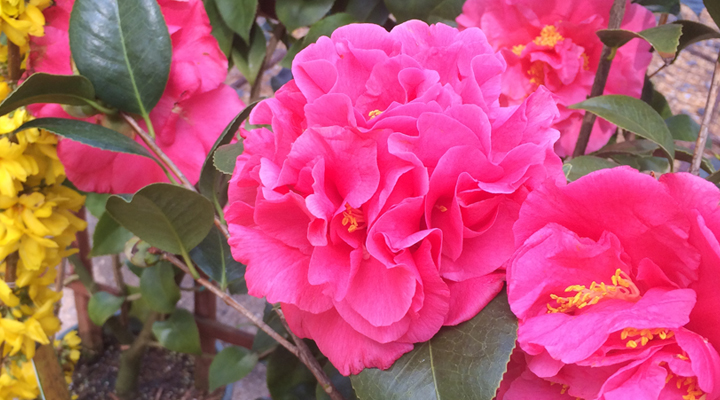Camellia Care and Planting Tips

Camellias have much to offer a shade landscape area; these shrubs feature year-round glossy, dark green foliage and display stunning single or double blooms in the winter. There are thousands of camellia hybrids, offering a large palette of colors from white and bi-colors to the deepest red.
There are large varieties, which can be formed into small trees or lower growing shrub types. Two main species of camellia are used here in Arkansas; sasanqua camellias bloom in the late fall to early winter and have smaller leaves and flowers. Japonica camellias bloom in the late winter or early spring and typically have larger leaves. There are also hybrids of cultivars on the market with desirable characteristic like cold hardiness. The later bloom season of japonicas make them more susceptible to a late frost. However, the large, multi-petaled flowers make the risk worth it! Camellias have a variety of uses in the landscape, including specimen plants, hedges and screens as well as container plantings.
Caring for Camellias
Camellia care is pretty simple; plant in a shade to part sun area (morning sun, afternoon shade) with rich soil. As the plants mature and the canopy provides shade to roots, they can take more sun. Camellias like ample moisture and well-drained soil. Water during dry conditions to encourage new growth. Camellias do not grow well when planted too deep. Plant 1-2 inches above surrounding grade, gently sloping soil up to the sides of the exposed root ball. Do not cover the root ball with soil; mulch around the plant, with a thin layer over the root ball; water well after planting.
Pruning Camellias
Prune to shape camellias as needed; prune selectively instead of shearing to maintain natural shape of the plants. Remove no more than one third of the plant at any one time. Thin dense branching when the foliage could be reducing room for flowers to properly open. Shortening lower branches will encourage a more upright growth pattern. Cut back leggy top growth to encourage a fuller plant form. Pruning should be done after the chance of frost has past in the spring and flowers have faded. Camellias set flower buds in late summer so pruning at the wrong time of year will significantly reduce blooming.
Fertilizing Camellias
Camellias like acidic soil conditions, which we tend to have in central Arkansas. Using a fertilizer for acid loving plants such as camellia/ azalea food after blooming will both provide necessary nutrients and help the soil retain the proper pH. Plant in soils with pH range of 5.5 to 6.5. If soil pH is incorrect, this may affect the ability of the camellia to absorb fertilizer.
We carry Evergreen/Azalea Food with Systemic Insecticide, which can also help with scale. Here in the southeastern United States, it is recommended that camellias be fertilized in March, May and early July. Rake the mulch back to the drip line of the plant, and apply the fertilizer directly to the soil. Water thoroughly after application. A pH test is always suggested when plants have specific needs; we have simple test kits available. With any fertilizer, read and follow instructions carefully.
Watch for These Symptoms on Camellias
These popular blooming evergreens are susceptible to scale. Treating with dormant oil and yearly with systemic insecticide soil drench can take care of this issue. The fertilizer suggested above also contains a systemic insecticide works well to control scale. Yellowing leaves might indicate a lack of iron. Test pH and adjust if it’s over 6.5. Treating with an iron supplement may be necessary.
Want to see which Camellias are in stock? Check our Inventory!